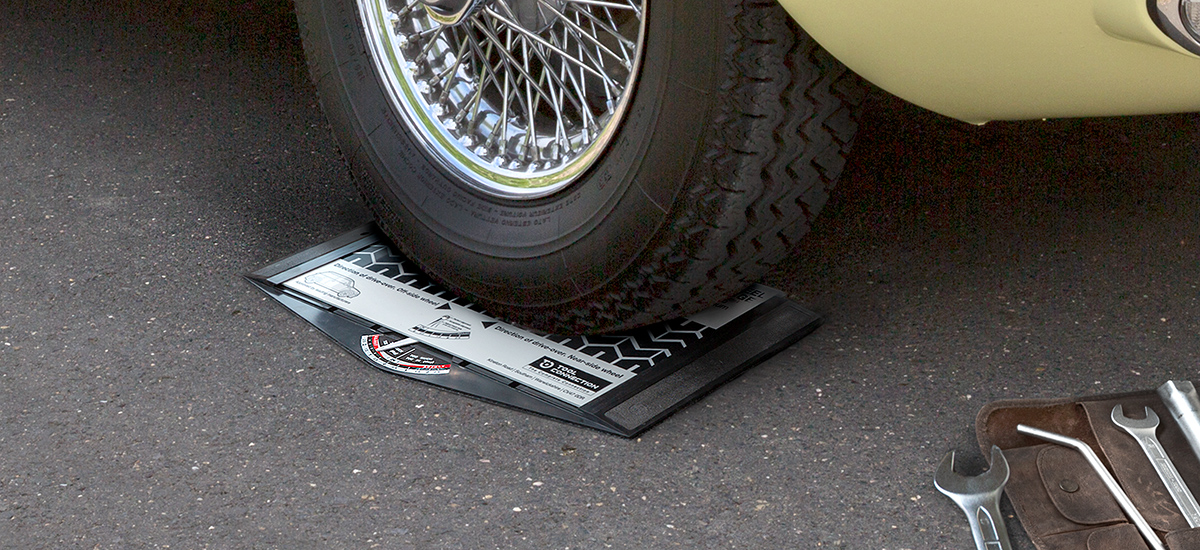Track adjustment
You know it - the tire runs off on one side, the steering wheel is slightly crooked and the car pulls to the left or right. Adjusting toe and camber solves this problem, which may have a massive impact on driving physics. The toe is the position of the right and left wheel in relation to each other, the camber is the angle of the tire perpendicular to the road. In the following article you will learn how you can check toe and camber yourself and which tools you need for this.

Poste : Ventes
Mise à jour : 25.10.2023

Toe and camber: a brief explanation
Toe is the position from the left to the right tire on a common axis. If the two tires are parallel to the longitudinal axis of the car, then this is called zero toe. If they turn inward (i.e. they would roll towards each other), then it is called toe-in. If the tires are outward (i.e. would roll away from each other) then that is toe-out.
One Zero lane is not normal - most cars have a toe-in or toe-out.
- Rear-wheel drive: Toe-in (inward inclination)
- Front-wheel drive: Toe-out (outward tilt)
How does an incorrectly adjusted track become noticeable?
Adjust toe: vintage car
An ideally adjusted track in turn ensures better grip on the road, which is noticeable in driving behavior. The car runs smoother and the steering reacts more precisely. A perfect track also contributes to your own safety. Classic vehicles in particular benefit from pleasant handling and precise steering. A comprehensive treatise on wheel alignment can be found in the specialist book by Vogel-Verlag.Adjust the toe: adjust the front axle exactly
Adjusting the axles or chassis is not part of the regular maintenance work on a car. It's only when your vehicle warps a bit, for example after driving into a deep pothole or over a curb, that it's time to adjust the alignment to improve driving physics and avoid tire wear.
- Too low tire pressure ...
... results in strong Fulling, i.e. the inner work of the tire components among themselves. This increases wear and fuel consumption due to high rolling resistance.
- Tyre pressure too high...
... reduces the contact area between the tire and the ground and thus the grip.Tires also wear out very quickly.
- Sawtooth formation
Adjust the track: tools and knife devices
There are several tools and devices that enable the adjustment of the track even for hobby mechanics without the technical possibilities of a car workshop. In the following you will find out more about the measuring devices and tools and whether they are suitable for classic and collector's vehicles.Note: in some cases, mistracking is the result of worn chassis components. Then the repair quickly becomes more complex and expensive. If you are not 100% sure about the diagnosis and repair, you should visit a specialist workshop and have the chassis damage assessed in connection.
Set track: Measuring plate for quick answers
- sloping ground
- different tire pressure
- tires that have been hit unequally
- Worn out wheel bearings
- uneven ground
- Steering wheel movements during test
- Jerky movement of vehicle
- Vehicle was not properly leveled before collision
- Suspension was not moved through before test
- Vehicle could roll backwards
- Worn out wheel bearings
- Heavy or uneven tire wear
- Incorrect tire pressure
Tip: The measurement will be even more accurate if you place a board or metal plate that is about the same thickness as the measuring plate under the tire, which is not currently being measured. This will prevent the small difference in height caused by the meter.
Toe setting: laser for precision measurements
Adjust camber: check the axle setting
The camber scale or camber scale helps to precisely determine the camber on the vehicle. The car is standing horizontally on a flat and smooth floor, a magnet ensures that the scales stick to brake discs, for example. Basically, the fall scale is a spirit level that is excellent for comparing measurements (before/after or right/left).
Conclusion: set the track with the right tool
It doesn't always have to be the specialist workshop if you have some knowledge and manual skills yourself. With the right measuring tool, you can adjust the toe and check the camber. An ideally adjusted chassis rewards you with longer tires and more precise steering, more traction, safety and driving pleasure - whether with the new car or the classic.
FAQ
Where does a warped Track at the car?
An incorrectly set track can have several reasons:
- Collision with potholes
- Riding on curbs
- Working on the car, e.g. replacing Chassis components
What is the point of an ideally set track?
What tools do I need to set the track?
- poss. a tire pressure gauge
- a measuring device or laser technology to measure the track
- a wheel camber to also check the camber
Is wheel alignment a standard service in garages
What about collector's vehicles?
Checking the track should be part of the annual check for your classic car, because only with ideal track or camber can you really enjoy the driving pleasure thanks to pleasant handling and precise steering.